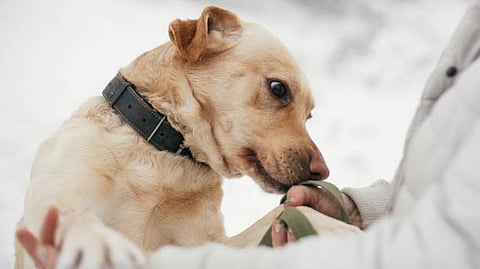

Dogs have been man's best companions for a very long time. It was King Frederick of Prussia who first made this statement in 1789. The value of dogs has been described in several religious texts written long ago. In the Sanskrit epic Mahabharatha, a dog named Dharma accompanies the eldest Pandava, Yudhisthira, throughout the journey to heaven. Dogs have always been there with us. We love dogs for their friendly, loyal, and loving nature. Now we have another big reason to love them. They can detect tumors.
Dogs are known for their spectacular sense of smell. Due to this, their help is sought in sniffing narcotics, explosives, and cadavers. Recent observations and studies have revealed that they also have a nose for sniffing cancer. There have been numerous reports of dogs sniffing out cancer in their owners.
When their dogs either continuously licked a specific body part, smelled their breath, or stared at a body part, the owners became suspicious. When they consulted physicians, most of them were diagnosed with cancer. For instance, a person whose dog repeatedly licked a lesion in his or her body was diagnosed with melanoma, the most severe form of skin cancer. Similarly, dogs can also detect breast cancer by pawing and staring at their owner's chest or ovarian cancer by sniffing the lower part of the abdomen in women.
But how is this possible? Well, dogs have around 250–300 million olfactory receptors in their noses, while humans have only 6 million. As a result, dogs have 1000–10,000 times the olfactory power of humans. Now, what causes the odor in cancer? Research showed that certain volatile olfactory compounds that dogs can detect are found in rapidly dividing cells, such as cancer. Polyamine, a volatile olfactory compound, was detected in the urine and blood samples of cancer patients.
Training dogs for cancer detection
Certain organizations are training dogs of different breeds to detect cancer. Dogs were given samples of urine, breath, and cancer tissue. In a study of the detection of lung cancer by sniffer dogs, the detection rates were 87.8% and 78% in urine and breath samples, respectively. Another study found that dogs could detect breast cancer from urine samples with 100% accuracy.
In the training process, the instructors make the dogs sniff more than 300 samples, which enables them to differentiate between healthy and cancerous samples.
Electronic Nose for Detecting Cancer
Recently, scientists have developed an advanced electronic nose that mimics a dog's nose. This device was created by combining machine learning and mimicking a dog's olfactory sensation. In addition to detecting cancer, the electronic nose is also designed to detect other diseases and explosives. Scientists are hoping to incorporate the features of an electronic nose into smartphones in the future.
Sources:
https://www.medicalnewstoday.com/articles/323620#research-and-diagnosis
https://www.akc.org/expert-advice/news/meet-americas-cancer-sniffing-canines/
https://newatlas.com/medical/electronic-nose-machine-learning-dogs-smell
